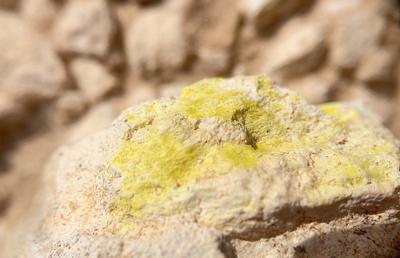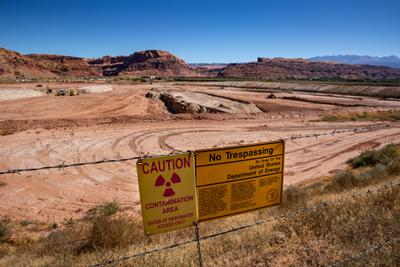The world will need up to 100,000 tons of uranium per year by 2040, which would mean doubling mining.
Another driver of the search for new sources of uranium, which is essential to nuclear reactors, is geopolitics. The U.S. and other countries are working to end their dependence on uranium from Kazakhstan and Russia — two of the world’s largest suppliers of the mineral. Since last April, the price for uranium has doubled, to more than $90 per pound, further helping to drive the global comeback. “Uranium Is Finally Running Hot, and Miners Can’t Keep Up,” read a recent headline in The Wall Street Journal.
Uranium companies are now using mining technologies, like in-situ leaching, that they claim will drastically reduce their environmental impacts. But based on the industry’s track record of polluting air, water, and soil with both radioactivity and heavy metals, and its obfuscation of mining’s environmental threats, many observers — especially Indigenous people, who have borne the brunt of past uranium mining and who still suffer health problems linked with unremediated mining sites — remain skeptical.
Exploration continues nonetheless. “Everyone is convinced there is going to be a much larger demand for uranium going forward,” said Matthew L. Wald, an energy analyst for the American Nuclear Society, a nonprofit organization that promotes nuclear power, and the Breakthrough Institute. “The domestic uranium mining industry is being brought back to life.”
“The utilities that serve most of the electric load in most of the U.S. are promising to reduce their carbon to near zero by 2050,” said Wald. Solar and wind will provide some of the needed power, but as the need for electricity soars, especially to charge electric vehicles, he said, “they are looking extremely eagerly at advanced reactors.”
If small modular reactors — units that can produce up to 300 megawatts of energy — prove efficient and economical, Wald says, they could be mass produced quickly and further increase the demand for uranium. There are plans for several small modular reactors, which have about one-third the generating capacity of traditional nuclear reactors, currently underway in the U.S. and Canada.
According to the International Atomic Energy Agency, the world will need up to 100,000 metric tons of uranium per year by 2040, which would mean nearly doubling mining from current levels. And so companies around the globe are both looking for new deposits and reopening old mines. In Canada, a giant new uranium mine received ministerial approval in November: After receiving its other approvals, the mine’s operators claim that the Rook 1 Project, in Saskatchewan, will in just a few years provide nearly a quarter of the world’s projected uranium needs. In India, the government has announced plans to open what would be one of that country’s largest mines, and a French company, Orano, just signed a deal to open two large mines in Mongolia, which would generate about 4 percent of the world’s uranium production.
Supporters of uranium mining say new methods are much cleaner than the open-pit mines of the past.
Greenland, meanwhile, is going against this trend. Concerned with the possible health impacts of mining, the Indigenous Inuit government in 2021 banned prospecting, exploration, and exploitation of uranium. And in 2023 it denied a permit for an Australian company to mine a massive deposit of rare earth metals called Kvanefjeld because bringing them to the surface would also convey uranium, with which it is commingled.
What will this new era of uranium mining mean for the environment? Historically, the industry has polluted groundwater, surface water, and soil around the world with radioactive waste and dust, heavy metals, and acid mine drainage. In some places, damage has been remediated by industry and government. But in many cases, due to cost or the difficulty of remediation, the pollution still contaminates the environment.
But supporters of uranium mining say that new methods and technologies are much cleaner than the open-pit mines of the past and have far smaller footprints. That’s because most new mines now use in-situ leaching, in which ore is left in the ground and miners recover the earth’s minerals by dissolving them with hydrogen peroxide or an acid or alkaline leach. The “pregnant” solution is then pumped to the surface, where uranium is extracted in a recovery plant.
In-situ mining — which requires a series of wells but no open pit — causes far less surface disturbance than open-pit mining, uses less water, and leaves behind no contaminated tailings or waste rock. Fifty-seven percent of the world’s total uranium was produced using in-situ leaching in 2019, up from 16 percent in 2000, according to the World Nuclear Association, an industry group.
“When [the U.S.] led the world in production in 1980, much of our production was conventional open pit and underground,” said Scott Melbye, president of Uranium Producers of America and CEO of Uranium Royalty, which provides capital for mines. “Eighty to 90 percent of production going forward [will be] coming from in-situ recovery.”
Mines in the U.S., he said, are held to extremely high standards compared with mines in some other countries, and nuclear energy is going to play a much larger role in the future of energy. “If we cross our arms and say we don’t want any mining in the United States, that just means you are willing to take stuff from Uzbekistan, Kirghizstan, and the Congo, where there is child labor and no attention paid to air quality or water quality or all those things.”
The controversial Pinyon Plain mine sits beneath Red Butte, on land that many tribes say is sacred.
In-situ mining, however, is not without risks, which include the contamination of groundwater with radon, heavy metals, and leaching fluids. The Obama administration proposed tighter standards to regulate byproduct materials produced by in-situ uranium mining, with a focus on groundwater protection and restoration, but the Trump administration rolled those regulations back. According to Geoffrey Fettus, former director the Natural Resource Defense Council’s recently shuttered nuclear program, before mining a site, “industry should be required to test the groundwater; then, once mining is done, it should clean up the water to the level it was before mining.” And finally, Fettus writes on the NRDC website, “it should transparently monitor the site to make sure the cleanup sticks, with either the EPA or the states overseeing this. It sounds straightforward, and it is.”
Those most skeptical of the new era of uranium mining are people who live near old mining sites across the American West, where the scramble to find uranium to build the first atomic bombs during the Cold War left open pits and radioactive waste piles and dust scattered across the landscape. A disproportionate number of these sites are on or near Indigenous land.
The U.S. Department of Energy is cleaning up radioactive uranium tailings at a former mine near Moab, Utah. George Rose / Getty Images
That’s one reason Pinyon Plain, in Arizona, has raised hackles. The mine sits beneath Red Butte, on land that many tribes, including the Hopi and the Havasupai, say is sacred.
In 2016, the mine’s owner, Energy Fuels Resources, was pushing forward with construction when it ruptured a perched aquifer — a confined pool of water sitting above the local water table. The company pumped this excess water into an open-air holding pond. But the pond wasn’t big enough, so the company used water cannons to spray the overflow, which was tainted with arsenic and uranium at levels well above federal standards, into the sky to enhance the evaporation rate.
Because it is in a sensitive natural and cultural area, the Pinyon Plain mine has raised objections from a long list of tribal officials and environmentalists. As Energy Fuels Resources pushes forward with mining, experts fear it could leak radioactivity into nearby groundwater that serves the Havasupai Tribe and flows into the waters of the Grand Canyon.
“The aquifer feeds the Grand Canyon springs,” said Taylor McKinnon, Southwest director of the Center for Biological Diversity. “They are incredibly important biologically and important to the Havasupai, whose name, People of the Blue-Green Water, ties to one of those springs.”
There are hundreds of abandoned uranium mines in the Four Corners region that have yet to be cleaned up.
Then there is the issue of mining waste that has been left in place for decades. “Depending on whose numbers you use, there are 500 or a thousand or more uranium mines in the Four Corners region, many of them on the Navajo Nation, that are abandoned and have yet to be reclaimed or cleaned up,” said McKinnon. He has worked on uranium issues in the Southwest since 2007 and is battling the Pinyon Plain mine because of its potential to contaminate groundwater. Many of those sites “continue to pollute,” McKinnon adds. “As you can imagine, that rightfully casts doubt on regulators and industry’s claims that it’s going to be done right this time.”
The largest accidental release of radioactive water in the U.S. occurred in 1979, when the tailings disposal pond at New Mexico’s Church Rock mine, owned by the United Nuclear Corporation, breached its dam and sent 94 million gallons of radioactive waste into the Rio Puerco. The water flowed onto the Navajo Nation, where radioactive pollution remains in waterways and in soil where livestock graze. Every year, the community commemorates the spill by walking to the site of the dam breach and offering healing prayers.
Studies have found that proximity to uranium mines increases the likelihood of illness, including kidney disease, hypertension, and other chronic diseases; a 2019 study revealed elevated autoimmunity in people living near abandoned mine sites on the Navajo Nation. “It’s not just the risk of radiation,” says Eric Jantz, an attorney at the New Mexico Environmental Law Center. “But also the chemical properties of mine waste”— including arsenic and other heavy metals — “that are really problematic from a public health standpoint.”
A mural on the Navajo Nation near Cameron, Arizona, cites cancer deaths among uranium workers. David McNew / Getty Images
The Inter-American Commission on Human Rights, part of the Organization of American States, held a hearing in February on the subject of uranium mining on Indigenous lands. Tribal leaders pointed out that much of the uranium mining was, in the U.S., carried out without the permission of Indigenous residents, and waste was often left behind. In the U.S., federal agencies often ignored or suppressed the dangers of uranium mining.
Jantz and tribal leaders are advocating for a moratorium “on all new uranium mining and milling on Indigenous lands or near culturally important sites until [the government] has remediated all legacy waste and implemented laws governing uranium development consistent with its human rights obligation.”
As the world electrifies to combat climate change, nuclear power is likely to become a growing part of the energy mix. “I’m all for responsible mining,” said David Kreamer, a professor of hydrology at the University of Nevada, Las Vegas, who has studied the Pinyon Plain mine. Uranium mining “can be done safely and be protective of the environment, but in many cases it’s not. It comes down to planning, regulation, and monitoring.”





